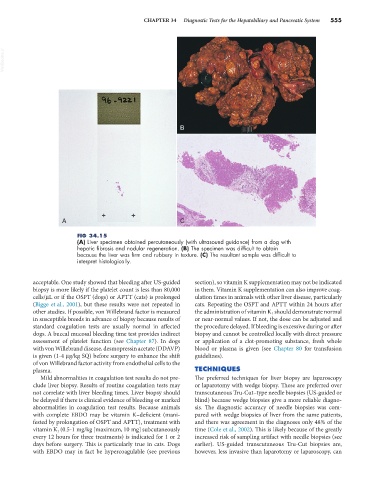Page 583 - Small Animal Internal Medicine, 6th Edition
P. 583
CHAPTER 34 Diagnostic Tests for the Hepatobiliary and Pancreatic System 555
VetBooks.ir
B
A C
FIG 34.15
(A) Liver specimen obtained percutaneously (with ultrasound guidance) from a dog with
hepatic fibrosis and nodular regeneration. (B) The specimen was difficult to obtain
because the liver was firm and rubbery in texture. (C) The resultant sample was difficult to
interpret histologically.
acceptable. One study showed that bleeding after US-guided section), so vitamin K supplementation may not be indicated
biopsy is more likely if the platelet count is less than 80,000 in them. Vitamin K supplementation can also improve coag-
cells/µL or if the OSPT (dogs) or APTT (cats) is prolonged ulation times in animals with other liver disease, particularly
(Bigge et al., 2001), but these results were not repeated in cats. Repeating the OSPT and APTT within 24 hours after
other studies. If possible, von Willebrand factor is measured the administration of vitamin K 1 should demonstrate normal
in susceptible breeds in advance of biopsy because results of or near-normal values. If not, the dose can be adjusted and
standard coagulation tests are usually normal in affected the procedure delayed. If bleeding is excessive during or after
dogs. A buccal mucosal bleeding time test provides indirect biopsy and cannot be controlled locally with direct pressure
assessment of platelet function (see Chapter 87). In dogs or application of a clot-promoting substance, fresh whole
with von Willebrand disease, desmopressin acetate (DDAVP) blood or plasma is given (see Chapter 80 for transfusion
is given (1-4 µg/kg SQ) before surgery to enhance the shift guidelines).
of von Willebrand factor activity from endothelial cells to the
plasma. TECHNIQUES
Mild abnormalities in coagulation test results do not pre- The preferred techniques for liver biopsy are laparoscopy
clude liver biopsy. Results of routine coagulation tests may or laparotomy with wedge biopsy. These are preferred over
not correlate with liver bleeding times. Liver biopsy should transcutaneous Tru-Cut–type needle biopsies (US-guided or
be delayed if there is clinical evidence of bleeding or marked blind) because wedge biopsies give a more reliable diagno-
abnormalities in coagulation test results. Because animals sis. The diagnostic accuracy of needle biopsies was com-
with complete EBDO may be vitamin K–deficient (mani- pared with wedge biopsies of liver from the same patients,
fested by prolongation of OSPT and APTT), treatment with and there was agreement in the diagnoses only 48% of the
vitamin K 1 (0.5-1 mg/kg [maximum, 10 mg] subcutaneously time (Cole et al., 2002). This is likely because of the greatly
every 12 hours for three treatments) is indicated for 1 or 2 increased risk of sampling artifact with needle biopsies (see
days before surgery. This is particularly true in cats. Dogs earlier). US-guided transcutaneous Tru-Cut biopsies are,
with EBDO may in fact be hypercoagulable (see previous however, less invasive than laparotomy or laparoscopy, can

